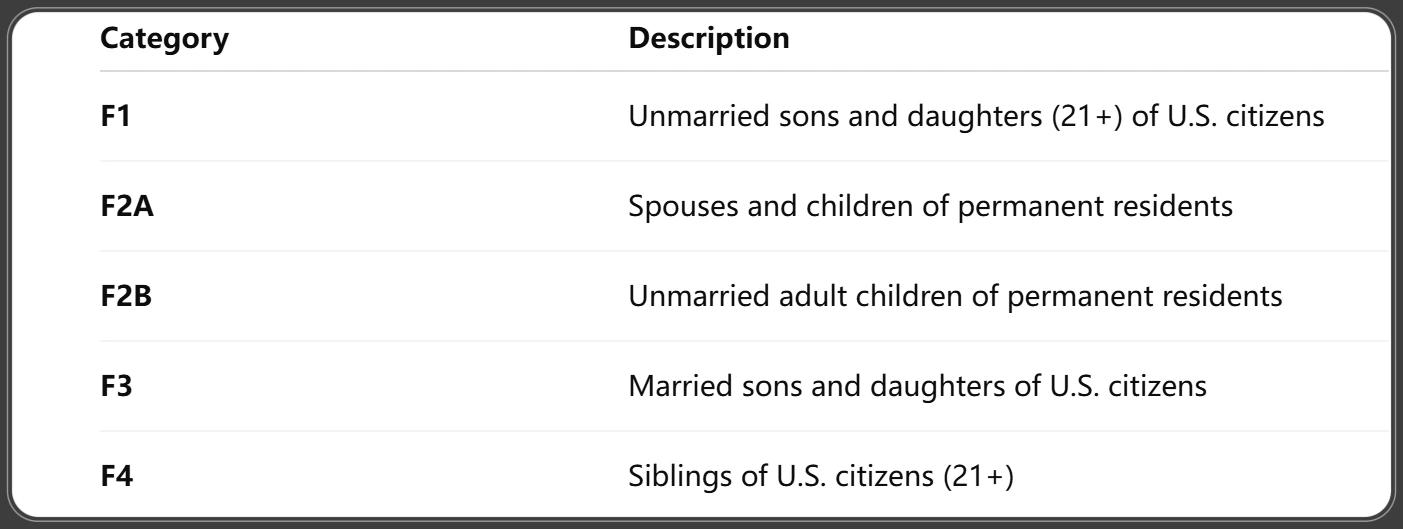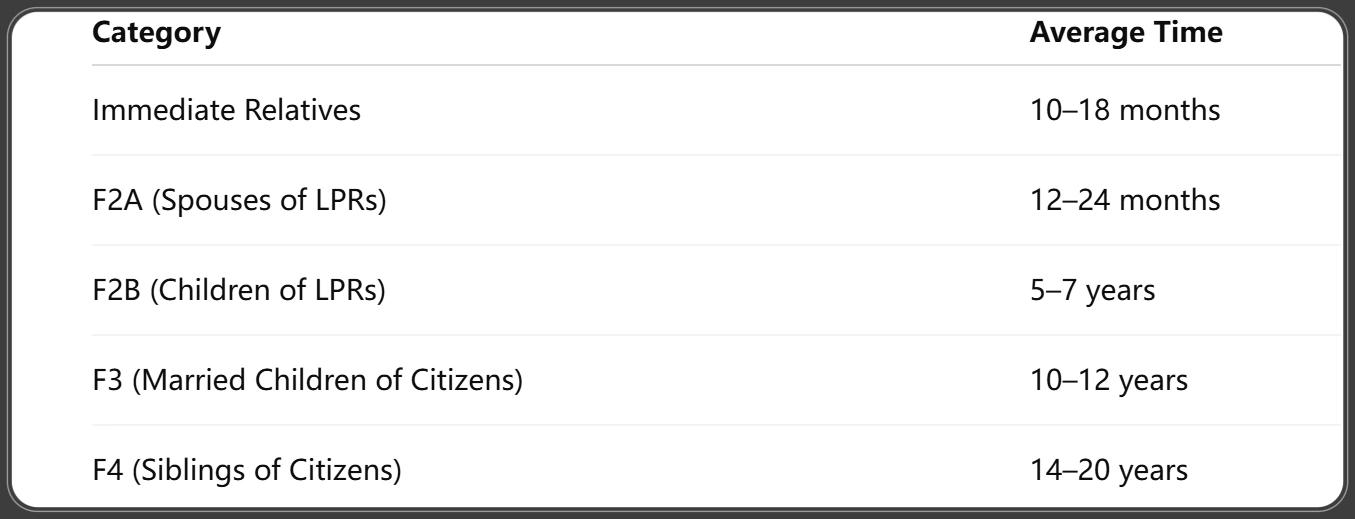Family Based Immigration Process 2025: Complete Guide to Petitions, Priority Dates, and Green Cards
Published on August 4, 2025

Sarah Martinez, J.D.
Immigration Attorney
Sarah Martinez, J.D., is an immigration attorney helping families navigate petitions, adjustments of status, and consular processes, with over a decade of hands-on legal experience.
Family Based Immigration Process 2025: Complete Guide to Petitions, Priority Dates, and Green Cards
In 2025, family-based immigration remains one of the most important legal pathways for bringing loved ones to the United States. However, the process can be lengthy and complex—with visa limits, shifting timelines, and evolving policies.
Whether you're a U.S. citizen hoping to sponsor your spouse or a green card holder petitioning for your child, this guide covers the family based immigration process 2025 from start to finish.
What Is Family-Based Immigration?
Family-based immigration allows U.S. citizens and lawful permanent residents (LPRs) to sponsor certain family members for lawful immigration to the U.S.
Legal Framework:
- Governed by the Immigration and Nationality Act (INA)
- Accounts for approximately 65–70% of all legal immigration to the U.S. annually
- Prioritizes family unity under U.S. immigration policy
Categories of Family-Based Immigration in 2025
There are two major categories for family-based immigration:
1. Immediate Relatives of U.S. Citizens
- Spouse of a U.S. citizen
- Unmarried child under 21 of a U.S. citizen
- Parent of a U.S. citizen (if the citizen is over 21)
➡️ No annual cap or visa limits.
2. Family Preference Categories
Subject to annual visa caps, meaning there can be wait times due to backlogs.

Who Can Sponsor a Family Member for Immigration?
U.S. Citizens Can Sponsor:
- Spouses
- Children (any age)
- Parents
- Siblings
Green Card Holders (LPRs) Can Sponsor:
- Spouses
- Unmarried children (any age)
Sponsors must be at least 18 years old and reside in the U.S. They also must meet income requirements and file Form I-864.
Step-by-Step Family Immigration Process
1. File Form I-130 (Petition for Alien Relative)
Establishes the family relationship.
2. USCIS Reviews and Approves the Petition
If approved, the case moves to the National Visa Center (NVC).
3. Check Visa Availability Using the Visa Bulletin
For preference categories only.
4. Complete DS-260 or I-485
- DS-260 (consular processing abroad)
- I-485 (adjustment of status in the U.S.)
5. Medical Exam and Background Checks
Required for all applicants.
6. Attend Interview
Conducted at a U.S. consulate or USCIS field office.
7. Receive Green Card
If approved, you become a lawful permanent resident.
Immediate Relatives vs. Preference Categories

How to File Form I-130 in 2025
Required Documents:
- Proof of petitioner’s citizenship or green card
- Marriage/birth certificates
- Passport photos
- Filing fee: $535 (as of 2025)
USCIS now allows online filing for most family petitions, improving processing efficiency.
Understanding the Visa Bulletin and Priority Dates
The Visa Bulletin, issued monthly by the Department of State, shows which family preference cases are eligible to proceed.
- The priority date is the date USCIS receives Form I-130.
- Watch the Visa Bulletin to see when your date becomes “current.”
What Happens After the I-130 Is Approved?
Once approved, the case moves to the NVC:
- Submit Form DS-260 (online immigrant visa application)
- Pay visa fees
- Upload civil documents (IDs, birth/marriage certificates)
- Submit Form I-864 Affidavit of Support
- Schedule interview at U.S. consulate
Adjustment of Status vs. Consular Processing

Choose the route that matches the beneficiary’s current location and legal status.
Green Card Approval and Conditions
After the final interview and approval, the beneficiary is issued an immigrant visa or green card.
For Immediate Relatives:
- Green card arrives within 45–90 days after entry or approval.
For Spouses (If Married Less Than 2 Years):
- You’ll receive a conditional green card valid for 2 years.
- Must file Form I-751 to remove conditions within 90 days before expiration.
Common Mistakes That Delay Family Immigration
Avoid these common errors to prevent delays or denials:
- Missing signatures or incorrect fees
- Inconsistent information on forms and documents
- Submitting expired civil documents
- Failing to respond to Requests for Evidence (RFEs)
- Not updating USCIS with address changes
Use the USCIS online account to track your case and stay updated.
Recent Changes to Family Immigration Policies in 2025
Notable Updates:
- E-filing expansion for Form I-130 and supporting evidence
- Interview waivers for certain spouse and child cases
- Faster biometric scheduling in key regions
- Increased use of AI to pre-screen applications for accuracy
These changes aim to improve efficiency and reduce the notorious family-based immigration backlog.
Financial Requirements for Sponsors in 2025
Sponsors must prove they can financially support the immigrant to avoid them becoming a “public charge.”
Key Forms:
- Form I-864 Affidavit of Support
- Based on 125% of the Federal Poverty Guidelines
- Sponsors must submit:
- Recent tax returns
- W-2s and pay stubs
- Proof of employment or assets
If your income doesn’t meet the threshold, you may use a joint sponsor.
Processing Times for Family-Based Green Cards in 2025

Processing can vary based on your country of origin, especially for high-demand countries like India, Mexico, and the Philippines.
Waivers and Appeals in Family Immigration Cases
Common Situations Requiring Waivers:
- Unlawful presence
- Previous visa overstays
- Misrepresentation
- Certain criminal records
Use Form I-601 or I-601A to request a waiver. Approval depends on proving “extreme hardship” to a qualifying U.S. relative.
If your I-130 is denied, you can:
- File a motion to reopen/reconsider
- Appeal to the BIA (Board of Immigration Appeals)
- Reapply with corrected documentation
Frequently Asked Questions About Family Immigration in 2025
1. Can a green card holder sponsor their parents?
No. Only U.S. citizens aged 21 or older can sponsor their parents.
2. Do children get green cards with their parents?
Yes, eligible unmarried children under 21 may be included as derivative beneficiaries.
3. Is DNA testing required for family petitions?
Not always—but USCIS may request it if documentary evidence is unclear.
4. Can my spouse work while waiting for their green card?
Yes, if they apply for work authorization (Form I-765) during adjustment of status.
5. Do I need to be physically in the U.S. to sponsor?
Yes. Sponsors must reside in the U.S. and intend to continue living there.
6. Can I travel while my I-130 is pending?
It depends on the applicant’s status. Advance parole may be needed for adjustment cases inside the U.S.
Conclusion: Bringing Families Together in 2025
Family reunification remains at the heart of U.S. immigration policy—and with the right preparation, the family based immigration process 2025 can lead to a successful and timely green card approval.
Final Checklist for Sponsors:
- ✅ Confirm your eligibility
- ✅ Prepare financial documentation
- ✅ Monitor the Visa Bulletin monthly
- ✅ File complete, accurate forms
- ✅ Be patient—it’s a process, but worth it
You Might Also Like
Affidavit of Support Sample 2025: Complete Guide with Example Template
Aug 14, 2025Family Based Green Card Backlog 2025: Causes, Updates, and Solutions
Aug 14, 2025I-485 Processing Time 2025: Complete Guide to Faster Green Card Approval
Aug 14, 2025I-130 Processing Time 2025: Complete Guide to Faster Approvals
Aug 14, 2025Marriage Green Card Timeline 2025: How Long It Takes and What to Expect Step-by-Step
Aug 4, 2025
